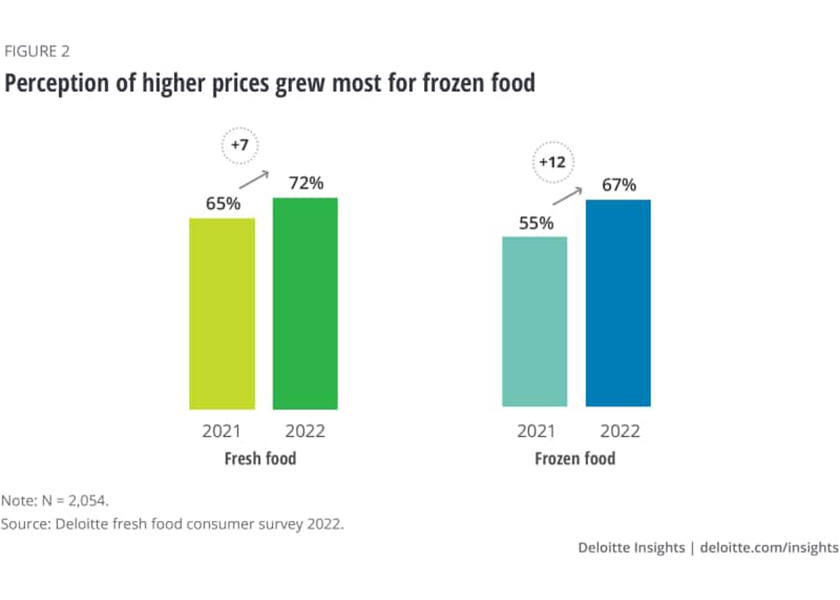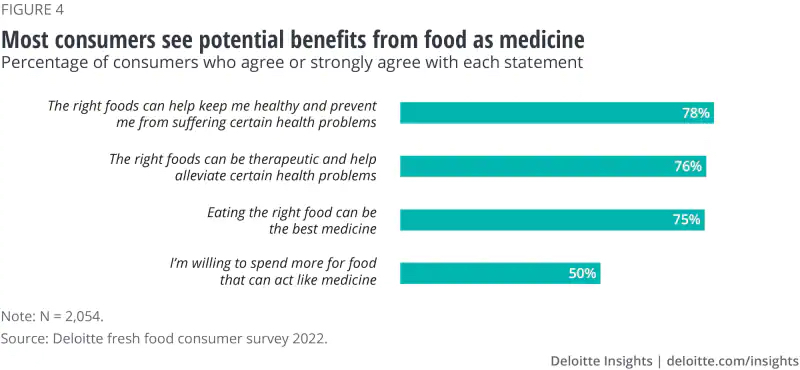How price-conscious shoppers still want food to be medicine

Even though price is influencing shoppers’ fresh produce decisions at retail more during these inflationary times, 55% of consumers say they are willing to pay a premium for the right foods because they contribute to their health and wellness.
That’s one of many findings released Sept. 26, in the “Fresh food as medicine for the heartburn of high prices” report conducted by Deloitte Insights in July.
For success, retailers and fresh food producers need to focus on information, access and ease of use, say the report’s authors, Daniel Edsall, Ed Johnson, Dr. Jay Bhatt and Spencer Young.
Though starting from a lower absolute price, frozen equivalents experienced about double the price inflation as fresh, and consumers in the survey appear to have noticed. And as far as units-sold, frozen food sales dropped even more than fresh food sales did, the report shows.
Price is drowning out other preferences.
Learn more: IFPA conference focuses on industry economic impact study
Shoppers are concerned about perishability and reducing food waste, but evidence points to this being an economic consideration more than an environmental one.
As purchase drivers, sustainability, locally-grown and non-GMO are lower than their prepandemic levels — down at least 12 percentage points from 2019, according to the report.
Buying edible wellness
How can health be a factor when price is king in shopper behavior?
While using the inherent healthy characteristics of fresh fruits and vegetables has long been a marketing strategy for retailers and producers, the Food as Medicine movement can offer a different avenue in the same direction.
In the U.S., more than 48 million households have a member with a health condition that needs to be managed through diet, according to the report. These households represent 60% of Americans and nearly $270 billion in annual grocery sales, according to Nielsen data, in research published jointly by the Food Industry Association, or FMI, and the Academy of Nutrition and Dietetics Foundation.
At least three in four consumers think fresh foods have preventative or therapeutic benefits, or at times can be the best medicine, the survey showed. Half of consumers are willing to spend more on food that can act as medicine.
However, in no case should the Food as Medicine concept detract from the importance of pharmaceuticals prescribed by a physician, emphasized the Academy of Nutrition and Dietetics Foundation.
Packaging it
Even though 80% believe fresh food is healthier for them than packaged or processed food marketed as healthy, packaged health products have more real estate to make health claims.
There’s an information gap.
- 62% of consumers cite conflicting information and confusion about the healthfulness of specific foods.
- Four in 10 consumers do not clearly understand which fresh foods can act like medicine.
- A little over half of the consumers say it’s essential to get data about food origins, safety and nutritional properties to confidently use food as medicine.
Some retailers are finding new ways to explain the nutritional benefits of fresh produce to their shoppers.
Guiding Stars labeling and signage helps brands such as Hannaford, The Giant Co., Food Lion and Stop & Shop.
The Kroger Co. and Kroger Health, which owns in-store pharmacies and retail health care clinics, have deployed registered dietitian nutritionists to help customers find healthier food in the grocery aisles. The company partnered with an insurance company to provide patients $75 per month to support healthier food choices and also piloted food prescriptions for people with diabetes.
Kroger also offers OptUP, a nutrition scoring system of 1 to 100 for individual food items as well as in aggregate for consumers, based on their own shopping data tracked over time. Registered dietitians created the score values using data science, evidence-based nutrition information and machine learning. The OptUP scores are on Kroger’s shopping website and app, which can also be used in-store.
Grocer-provided apps are a way to close that information gap between fresh produce and its health outcomes, the report says.
These are a few ways to take action on this wellness connection, according to the authors:
- Any health claims for food should be backed by science and properly stated. Use registered dietitians and other medical professionals to validate claims.
- Just like a store would stock products at different price points and good, better and best quality, make sure you are providing options that serve customers’ health needs, including for specific groups such as diabetics, people with heart conditions or those with food allergies.
- Partner with organizations that provide context, come with resources, and fill critical gaps. For instance, insurers may be able to provide financial resources due to their built-in incentives for improved health. Organizations like Guiding Stars Licensing Co. or Good Measures have data maps between food products and nutritional properties.
- Consider building program elements to serve employees and people in the community who are fresh-food insecure.
- Scaling a registered dietitian’s guidance takes technology. The best apps can accommodate health profiles with data from multiple sources and keep nutrition guidance simple.
- Food producers should provide detailed health and safety information in close partnership with retailers. Providing this data to customers in a food-as-medicine context could generate more value from investments undertaken to meet proposed new FDA traceability requirements.
- Leverage in-store pharmacies. While initial efforts may need to rely on consumers completing profiles, establishing ways for customers to share their data from the pharmacy could provide much richer profiles to personalize recommendations. This also requires a good understanding and compliance with legal, regulatory and ethical rules.
- It is not a giant leap to envision fresh-food producers and grocers joining forces with clinical providers and payors to serve people’s needs.

And then there are ways to take action on the inflationary pressures that shoppers feel:
- Make it easy and guilt-free for consumers to use food assistance benefits in stores, but especially online. More than one in 10 people in the U.S. are using Supplemental Nutrition Assistance Program, or SNAP, benefits. Still, only a small fraction of the 250,000 retail locations that accept these benefits accept SNAP electronic benefit transfer payments online. These consumers need the convenience of online ordering and delivery.
- Facilitate trade-downs. Anticipate where consumers are moving and have that inventory on hand, using creative placement of products on shelves, and highlighting preferred alternatives in search results. This includes manufacturers creating lower-tier brand variants. Re-engineer these products to focus on attributes that consumers care about most. Stripping away nonvalued features and ingredients can lower costs while improving relevancy in the consumers’ eyes.
- Grow private-label offerings. Consumers prefer to change from name brand to private label rather than switch forms, such as buying canned food instead of fresh.
- Provide clarity on pricing. Keep costs down as much as possible, practice fair pricing, and when prices must be raised, make sure partners and consumers understand the reasons behind it. Transparency throughout the value chain helps others trust intent and could reduce suspicion of price gouging.
- Help consumers avoid waste. Consumers do not want to waste food, especially now. Anything that helps consumers eat what they buy before it goes bad will help. Help could come in several forms — appropriate package sizes, optimizing cold chains to present food as fresh as possible, or even education about storage tricks and best-by dates.
- Food manufacturers can work with retail partners to limit abusive shopper behaviors, such as coupon stacking and other promotional manipulation. Some retailers are now using their customer data platforms and digital coupon systems to limit the audiences for digital coupons to those customers who either need them most or will respond best to them. Retailers may discourage cherry-picking by not laying out all the sale items in one place, which makes grabbing sale items and moving to the next store easier. Consider using loyalty programs to provide incentives based on overall basket size to encourage filling entire shopping lists in one place.







